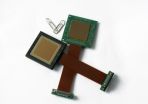(Press-News.org) »Goal, goal, goal!« fans in the stadium are absolutely ecstatic, the uproar is enormous. So it's hardly surprising that the security personnel fail to spot a brawl going on between a few spectators. Separating jubilant fans from scuffling hooligans is virtually impossible in such a situation. Special surveillance cameras that immediately spot anything untoward and identify anything out of the ordinary could provide a solution. Researchers from the Fraunhofer Institute for Applied Information Technology FIT in Sankt Augustin have now developed such a device as part of the EU project »SEARISE – Smart Eyes: Attending and Recognizing Instances of Salient Events«. The automatic camera system is designed to replicate human-like capabilities in identifying and processing moving images.
Like the human eye, it can, for instance, distinguish objects when observing a scene, even if the objects are moving in front of a very turbulent background. The Smart Eyes system analyzes the video data in real time and immediately points out salient features. »That is invaluable for video surveillance of public buildings or places«, says Dr. Martina Kolesnik, research scientist at the FIT. »In certain circumstances the capabilities of a human observer are limited. Ask someone to keep an eye on a certain stand in a football stadium and they are bound to miss many details. That same person can only carefully monitor certain sections of the whole area and will quickly get tired. That's where Smart Eyes clearly comes into its own.«
The system hardware consists of a fixed surveillance camera which covers a certain area, and two ultra-active stereo cameras. Like human eyes, these can fix on and follow various points very quickly in succession – but also zoom in on details. At the heart of Smart Eyes is innovative software that automatically analyzes the image sequences. It replicates key strategies of the human eye and brain. Taking its lead from the flow of visual images in the brain, the software has a hierarchical, modular structure. It initially ascertains the degree of movement for each pixel, thus identifying the particular active areas in the scene. From this it learns motion patterns and stores them as typical models. On the basis of these models the system then identifies events and classifies them: for instance the software can distinguish between passive spectators and fans jumping up and down. Image patterns such as empty seats or steps are also identified. The application picks out salient events and focuses on these using the active stereo cameras. Depending on the priorities set by the security experts, various events are designated as salient. The program can, where necessary, filter out objects such as flags being waved to focus specifically on other salient events, for instance a person on the edge of the pitch. »Our image analysis software is compatible with camera systems produced by all vendors. It can be installed easily. The user doesn't have to make any adjustments«, says the researcher. The Smart Eyes system will be on show at Security Essen 2010 from October 5-8, 2010.
INFORMATION:
Vigilant camera eye
2010-09-20
ELSE PRESS RELEASES FROM THIS DATE:
Image sensors for extreme temperatures
2010-09-20
More and more car manufacturers are equipping their vehicles with image sensors – e.g. to register the presence of pedestrians or vehicles in the blind spot or to detect obstacles when parking. The sensors must be able to function in extremely high temperatures and in blazing sunlight. If they are installed behind the rear view mirror or on the instrument panel, for example, they can get very hot. The Fraunhofer Institute for Microelectronic Circuits and Systems IMS in Duisburg has developed a CMOS (complementary metal oxide semiconductor) image sensor for an industrial ...
Taking the pulse of coral reefs
2010-09-20
Healthy reefs with more corals and fish generate predictably greater levels of noise, according to researchers working in Panama. This has important implications for understanding the behaviour of young fish, and provides an exciting new approach for monitoring environmental health by listening to reefs.
Contrary to Jacques Cousteau's 'Silent World', coral reefs are surprisingly noisy places, with fish and invertebrates producing clicks and grunts which combine to produce cacophonies of noise. Each reef is subtly different depending on the size and composition of the ...
Earth's highest coastal mountain on the move
2010-09-20
The rocks of Colombia's Sierra Nevada de Santa Marta—the highest coastal mountain on Earth—tell a fascinating tale: The mountain collides and then separates from former super-continents. Volcanoes are born and die. The mountain travels from Peru to northern Colombia and finally rotates in a clockwise direction to open up an entirely new geological basin. Smithsonian scientists were part of a four-year project to study Santa Marta's geological evolution. Their findings are published in the October 2010 special issue of the Journal of South American Earth Sciences.
The study ...
Returning troops face both physical and mental challenges
2010-09-20
Is the US health system comprehensively meeting the needs of returning veterans? With the recent attention to mental illness in returning soldiers, and post-traumatic stress disorder (PTSD) in particular, little research has focused on the medical care needs of those returning from Operation Enduring Freedom/Operation Iraqi Freedom, according to Dr. Susan Frayne, from the VA Palo Alto Health Care System and Stanford University, and colleagues.
Their research highlights that veterans suffering from PTSD also suffer more medical illnesses than do those with no mental health ...
Cholesterol drug may have role in treating prostate cancer
2010-09-20
TORONTO, Ont., Sept. 20, 2010 – A drug commonly prescribed for people with high cholesterol may also be effective in treating prostate cancer, according to new research by Dr. Xiao-Yan Wen at St. Michael's Hospital.
Rosuvastatin—a statin drug sold as Crestor—suppressed the growth of transplanted human prostate cancer cells in mice.
"Our data provided solid pre-clinical evidence and a strong rationale for clinical trials of statins in the treatment of prostate cancer," said Wen, whose research appears in the September issue of European Urology, the journal of the European ...
Study: Privacy key obstacle to adopting electronic health records
2010-09-20
The United States could achieve significant health care savings if it achieved widespread adoption of electronic health records (EHRs), but insufficient privacy protections are hindering public acceptance of the EHR concept, according to a new paper from researchers from North Carolina State University. The paper outlines steps that could be taken to boost privacy and promote the use of EHRs.
"Electronic health records could reduce costs in the U.S. by an estimated $80 to 100 billion each year," says Dr. David Baumer, head of the business management department at NC State ...
Kids and diabetes risk: Do chromosomes hold new clues?
2010-09-20
Children who have a high risk of developing type 2 diabetes might be identified earlier by way of tell-tale genetic indicators known as biomarkers. Some of those new biomarkers might be pinpointed in research led by Nancy F. Butte and funded by the U.S. Department of Agriculture (USDA) and the U.S. Department of Health and Human Service's National Institutes of Health.
Butte is with the USDA Agricultural Research Service (ARS) Children's Nutrition Research Center at Baylor College of Medicine in Houston, Texas, where she is a professor of pediatrics. ARS is USDA's principal ...
Plague researchers race to beat bioterrorists
2010-09-20
Saranac Lake, N.Y. – Given the many pressing concerns of the day, fear of plague probably isn't what causes most Americans to lose sleep. But for those whose responsibility it is to combat bioterrorism, plague is among the highest priorities. Those charged with that mission include scientists like medical researcher Steve Smiley, whose lab at the Trudeau Institute is working to develop a vaccine that will protect the public against weaponized forms of plague. The Institute, which is dedicated to studying how the immune system responds to infectious diseases, is at the forefront ...
No pain in the hospital -- wishful thinking or reality?
2010-09-20
More than 80% of hospitalized patients suffer more severe pain than necessary. This is the conclusion of Christoph Maier (Bochum University Hospital, Bochum, Germany) and his coauthors in their interim report of the Pain-Free Hospital Project ("Schmerzfreies Krankenhaus"), which appears in the current issue of Deutsches Ärzteblatt International (Dtsch Arztebl Int 2010; 107[36]: 607-14). The project, which was initiated in 2003, has the goal of improving pain management in hospitals across Germany.
To study the quality of pain therapy, the authors evaluated anonymous ...
Fidgety children are on the rise
2010-09-20
Hyperkinetic disorders among children and adolescents are becoming increasingly common. In the current issue of Deutsches Ärzteblatt International, Ingrid Schubert of the PMV Research Group at the University of Cologne and her colleagues address the question how this has affected the frequency of prescriptions for methylphenidate, a stimulant drug that is used to treat such disorders (Dtsch Arztebl Int 2010; 107[36]: 615¬21). The authors analyzed data concerning tens of thousands of persons insured by the AOK health insurance company in the German state of Hesse over the ...




